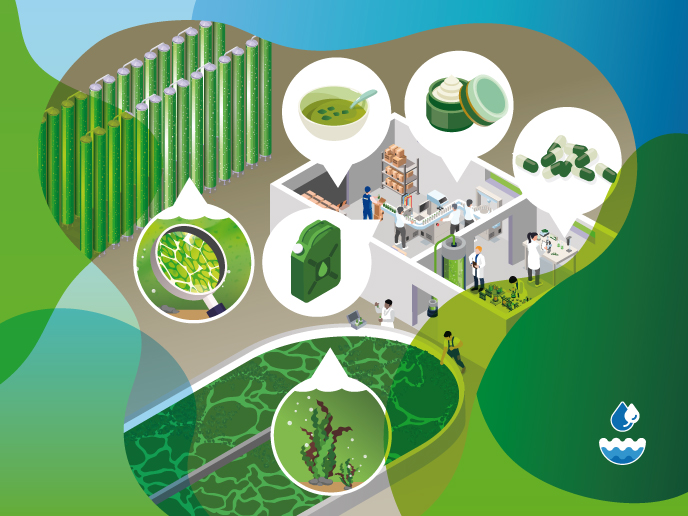Algae innovation: Sustainable alternatives emerging from European seas and waters
Algae are an overlooked resource. Ranging from towering kelp to tiny microalgae, they can be cultivated in marine and freshwater habitats, ponds or photobioreactors. Algae can be highly productive, and some can make use of atmospheric nitrogen for rapid growth. Microalgae in particular are amenable to a range of production methods, from open systems using sunlight, to closed bioreactors that run on a fermentation process. They can be produced in high quantities on land not suitable for arable production, and require a fraction of the water needed for terrestrial crops, and can even be reared on wastewater as part of a bioremediation process. Macroalgae, also known as seaweed, absorb a range of excess inorganic nutrients from the ocean, including nitrogen and phosphorus as well as other compounds such as carbon, thereby reducing ocean acidification. They can be cultivated at sea (offshore) or onshore in ponds, greenhouses and raceway systems. As demand for food and sustainable products increases, algae offer a sustainable way to deliver these while reducing impact on the environment. The farm to fork strategy supports the role of algae in the transition to plant proteins and its contribution to a sustainable food system. The use of algae could reduce the pressure on plant biomass derived from agriculture and forestry. Eaten as food, they are low in fat and rich in fibre, protein and micronutrients. The farming of algae can also contribute to achieving the EU’s objectives in terms of decarbonisation, zero pollution, circularity, the preservation and restoration of biodiversity, the protection of ecosystems and the development of environmental services. Strategic guidelines for a more sustainable and competitive EU aquaculture stress the need to promote the farming of algae as a way of contributing to the goals of the European Green Deal. In addition, the European bioeconomy strategy and the blue growth strategy stress the potential of algae, while the recent communication ‘Towards a strong algae sector’ aims to boost research, facilitate market access and increase consumer awareness and acceptance of algae products. Research and investment, including the Horizon programme, play a crucial role in delivering the innovations necessary to advance the production and valorisation of algae. The projects featured in this Pack cover a range of applications, including fundamental insights into the role of algae in the carbon cycle, the development of new and improved algae production systems, the use of algae in bioremediation, and the delivery of products such as animal feed, pharmaceuticals, cosmetics, yoghurt pots and more. Support for algae innovation continues across Horizon Europe and other funding programmes, including the European Maritime and Fisheries Fund, which is supporting projects including ALGAENAUTS, KELP-EU, ULVA FARM and Seafood Algternative. Pilot-scale bioreactors from the ALEHOOP, Biosolar Leaf and Cyanobacteria projects successfully demonstrated the feasibility of sustainable plant-based protein, while facilities developed by MULTI-STR3AM and AlgaeCeuticals used microalgae to produce pharmaceutical and cosmetic compounds. Looking to algae in the environment, MARINEGLYCAN is advancing our understanding of how the oceans sequester CO2 in algal biomolecules, while the e-shape project used Earth observation imagery to protect coastal environments from algae blooms. The ASPIRE project advanced the knowledge needed for commercial cultivation of dulse seaweed. The FLEXI-GREEN FUELS project was able to turn woody waste into sustainable biofuel and nutraceuticals, NENU2PHAR showed algae can offer an alternative to fossil fuel-based plastics, and WWTBP-by-Microalgae demonstrated a bioremediation system that produces biofuel and blue pigment as a side stream.



